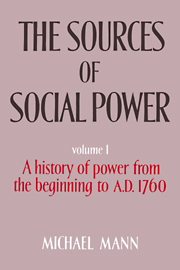Book contents
- Frontmatter
- Contents
- Preface
- 1 Societies as organized power networks
- 2 The end of general social evolution: how prehistoric peoples evaded power
- 3 The emergence of stratification, states, and multi-power-actor civilization in Mesopotamia
- 4 A comparative analysis of the emergence of stratification, states, and multi-power-actor civilizations
- 5 The first empires of domination: the dialectics of compulsory cooperation
- 6 “Indo-Europeans” and iron: expanding, diversified power networks
- 7 Phoenicians and Greeks: decentralized multi-power-actor civilizations
- 8 Revitalized empires of domination: Assyria and Persia
- 9 The Roman territorial empire
- 10 Ideology transcendent: the Christian ecumene
- 11 A comparative excursus into the world religions: Confucianism, Islam, and (especially) Hindu caste
- 12 The European dynamic: I. The intensive phase, A.D. 800–1155
- 13 The European dynamic: II. The rise of coordinating states, 1155–1477
- 14 The European dynamic: III. International capitalism and organic national states, 1477–1760
- 15 European conclusions: explaining European dynamism – capitalism, Christendom, and states
- 16 Patterns of world-historical development in agrarian societies
- Index
4 - A comparative analysis of the emergence of stratification, states, and multi-power-actor civilizations
Published online by Cambridge University Press: 26 December 2009
- Frontmatter
- Contents
- Preface
- 1 Societies as organized power networks
- 2 The end of general social evolution: how prehistoric peoples evaded power
- 3 The emergence of stratification, states, and multi-power-actor civilization in Mesopotamia
- 4 A comparative analysis of the emergence of stratification, states, and multi-power-actor civilizations
- 5 The first empires of domination: the dialectics of compulsory cooperation
- 6 “Indo-Europeans” and iron: expanding, diversified power networks
- 7 Phoenicians and Greeks: decentralized multi-power-actor civilizations
- 8 Revitalized empires of domination: Assyria and Persia
- 9 The Roman territorial empire
- 10 Ideology transcendent: the Christian ecumene
- 11 A comparative excursus into the world religions: Confucianism, Islam, and (especially) Hindu caste
- 12 The European dynamic: I. The intensive phase, A.D. 800–1155
- 13 The European dynamic: II. The rise of coordinating states, 1155–1477
- 14 The European dynamic: III. International capitalism and organic national states, 1477–1760
- 15 European conclusions: explaining European dynamism – capitalism, Christendom, and states
- 16 Patterns of world-historical development in agrarian societies
- Index
Summary
Does my model of the caging impact of alluvium and irrigation on overlapping regional power networks apply to other cases as well as to Mesopotamia? Were they also essentially dual, combining small, intense city-states within a segmental, multistate civilization? I consider this in the briefest possible terms, examining only whether the other cases would seem to fit broadly into, or deviate from, the general model. I will spend more time on deviations, suggesting, where I can, their possible causes. Let me add that I respect the unique and the ideographic in local histories. All these cases were different. I expect the model to be of suggestive, not mechanical, application.
I start with the cases that seem most similar, those of the Indus Valley and China. Then I move to a case whose origins may be broadly similar but whose later development is quite different – that of Egypt. Then I discuss the final, possibly independent, and, if so, distinctly deviant, Eurasian case – that of Minoan Crete. Finally, I shift continents to the two American cases, which offer generally greater difficulties to the model. In conclusion, I delineate the dominant path taken to civilization, stratification, and states.
The Indus Valley civilization
Sometime around 2300 to 2000 B.C. (exact dating is not possible), there existed a literate, urban, ceremonially centered civilization in the Indus Valley in present-day Pakistan. We do not know much about this civilization, and we will not until its script is deciphered. Scholars believe its origin to be largely indigenous, its civilization and state “pristine.”
- Type
- Chapter
- Information
- The Sources of Social Power , pp. 105 - 129Publisher: Cambridge University PressPrint publication year: 1986



